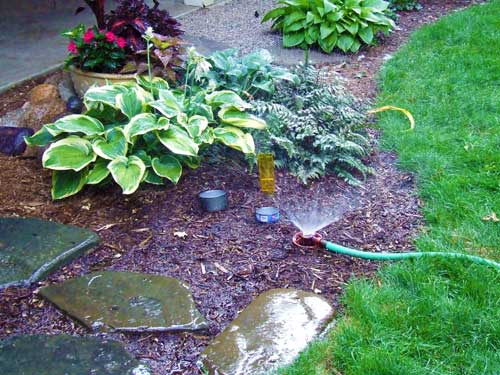The last word on watering perennials
Watering perennials during droughty weather helps plants along, but are you really making a difference?
Many parts of Michigan haven’t seen significant rain in weeks. As the soil moisture ‘bank” is depleted, some plants won’t benefit from light irrigation or rainfall. Caring for perennial plants during this period of time will insure bountiful blooms for next year.
If standing at the edge of the bed, squirting water on the plants is what you had in mind, think again! Most of our popular perennial plants have much deeper roots than annuals or turf. Hand watering a perennial bed may result in pockets of moisture, but it does not insure that water is where it is most needed – deep in the root zone. It may surprise you to get out a garden spade and simply turn over an 8-inch slice of soil. Usually the top 1 to 2 inches will be moist where you hand-watered, but down deep may still be powder dry.
Drip, drip, drip!
Perennials are forgiving for drought conditions, but with 2012’s early spring, coupled with many days of wind and low humidity conditions, soils dried out deeper and earlier than normal. Heading into July, if we continue along a traditional summer weather pattern, replenishing that “bank” of soil moisture will not soon be forthcoming.
To remedy this situation, turning on a small sprinkler or drip hose at the base of your plants and letting it run for three to four hours may bridge the gap to when we finally get adequate rainfall.

Nestle a small sprinkler at the base of your perennials, just allowing it to
emit a small amount of water for three to four hours. Measure your output
by using tuna cans or a rain gage.
If you use a traditional sprinkler over the top of the plants, coverage is also important. Sprinklers are great, but seldom do they distribute water evenly in their path. A great way to check the coverage of your sprinkler is to cut the lid off of clean tuna (or cat food) cans and set them out in an even pattern across the swath of the sprinkler. Run for 15 minutes and measure the water in each can. You will then know how much water you are delivering as well as how evenly.
Overhead irrigation, especially at night can also exacerbate fungal pathogens such as powdery mildew and create conditions conducive for slug damage. Be watchful that your irrigation that hits the foliage has enough time to dry off before evening sets in.
Find out about other educational resources and classes at www.migarden.msu.edu and at Finneran’s blog. You can contact the MSU Master Gardener Lawn and Garden Hotline at 888-678-3464 with your questions.
Additional information
- MSU Extension’s Drought Resources



 Print
Print Email
Email


